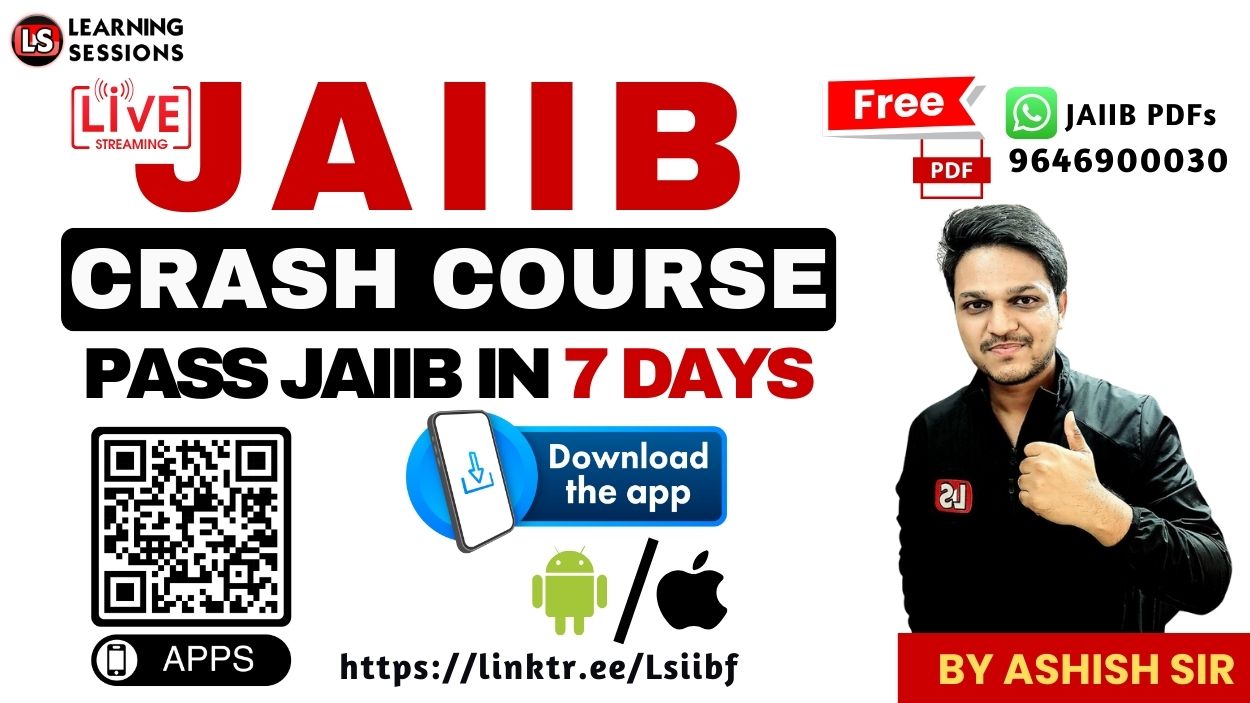Are you preparing for the JAIIB or bank promotion exams and feeling overwhelmed by the number of government-sponsored schemes like PMAY, PMJDY, PMEGP, APY that keep changing in guidelines each year? You’re not alone. A surprising number of candidates lose easy marks simply because they couldn’t keep up with the latest updates.
In this extended blog—based on our latest YouTube session—we’ll dive deep into the most important MCQs for the chapter “Government Sponsored Schemes” (Module B of PPB) and decode them with easy-to-understand examples, simple analogies and memory tricks. Everything is updated for 2025 norms of RBI, IBA and scheme guidelines.
📚 JAIIB Study Resources 📚
👉 Check Here
👉 Check Here
👉 Check Here
👉 Get Tests Here
👉 Check Here
Whether you’re a bank employee preparing for JAIIB/PPB, a student of banking & finance, or simply someone keen to understand how key government schemes function—this article is built just for you.
Watch Full Video
Have you ever wondered why PMAY has so many types like CLSS, AHP, ISSR and especially BLC (Beneficiary Led Construction)? Let’s simplify it.
Imagine you’re a banker dealing with a case where a family received their first instalment under the BLC vertical, but construction got stalled for over a year. What should you do? According to the guidelines, the implementing agency (usually the ULB) must initiate recovery of the disbursed funds to ensure the project completes or the money is returned.
Key Highlights:
- Target groups: EWS (Economically Weaker Section), LIG (Low Income Group) and MIG (Middle Income Group).
- Maximum subsidy under CLSS for EWS/LIG: up to ₹2.67 lakh (on dated guidelines; verify the latest figure before exam).
- For the BLC vertical, timelines matter: delays may trigger recovery.
- Implementing agency is usually the Urban Local Body (ULB) or State Govt selected agency.
Exam Tip: Remember one scenario – “stall > 1 year after first instalment → recovery by ULB” and you’ll handle many MCQs on PMAY with confidence.
2. APY – Atal Pension Yojana
Think of APY as an umbrella you open early so you stay covered in your prime age and retire safely. But what happens if the subscriber dies before retirement age? That’s one of the frequently asked questions.
Here’s a scenario: Mr. Amit (age 35) registers for a ₹3,000/month pension but sadly passes away at age 50. His wife, Mrs. Smriti, wants to continue the scheme. What should she do?
Answer: She can be the nominee and continue contributing till the original subscriber would have turned 60, and thereafter begin receiving the pension in her name.
Facts to remember:
- Entry age: 18-40 years (you must join within this age).
- Pension options: ₹1,000, ₹2,000, ₹3,000, ₹4,000 or ₹5,000/month depending on contribution.
- Government co-contribution: Available only for early joiners (2015-16) and for 5 years; later changed/ceased.
- The spouse/nominee gets the benefit in case of subscriber’s death and the pension starts when original age 60 is reached.
Memory aid: “18-40 join, 60 retire” – first join by 40, pension accrues at 60. Bookmark this for APY MCQs.
3. PMEGP – Prime Minister’s Employment Generation Programme
This scheme is all about enabling micro entrepreneurs to start manufacturing/service/trading units. Let’s look at a strong practical example.
Example: Mr. Arvind (SC category) sets up a manufacturing unit in a rural area at a project cost of ₹20 lakh under PMEGP. Here’s how funding splits:
- Category: Special (SC/ST) → so margin money subsidy = 35%, own contribution = 5%.
- Project cost = ₹20 lakh → Subsidy = 35% of ₹20 lakh = ₹7 lakh. Own contribution = 5% of ₹20 lakh = ₹1 lakh. Bank loan = rest → ₹20 lakh – (₹7 lakh+₹1 lakh) = ₹12 lakh.
Funding Matrix – 2025 Guidelines:
| Eligibility Category | Location | Subsidy % | Own Contribution % |
|---|---|---|---|
| General | Urban | 15% | 10% |
| General | Rural | 25% | 10% |
| SC/ST/Women (Special) | Urban | 25% | 5% |
| SC/ST/Women (Special) | Rural | 35% | 5% |
Exam-worthy trick: If you spot “Rural + SC/ST/Women + Manufacturing” think “35% subsidy, 5% own contribution”.
4. PMJJBY – Pradhan Mantri Jeevan Jyoti Bima Yojana
This scheme offers life cover at very low cost – but the catch lies in timing, revival, waiting periods and conditions.
Scenario: Mrs. Nirmala has a saving account linked policy. On 31 May the premium auto-debit fails due to insufficient funds. She restores the policy on 15 August with good-health certificate. Sadly, she passes away on 5 September from a non-accidental cause. Will her nominee get the claim?
Answer: No. The policy had lapsed on 31 May, and after revival on 15 August there is a waiting period of **45 days** for non-accidental death. Her death is within 21 days of revival so claim is denied.
Mastering Personal Finance & Laws relating to Bill Finance for JAIIB PPB
Important points:
- Annual premium = ₹436 (in many banks; check the latest)
- Sum insured = ₹2 lakh
- Entry age: 18-50 years (renewable to 55)
- Waiting period for non-accidental death after revival = 45 days.
For accidental death, cover is immediate (no waiting). - Linkage: Policy must be linked to a savings bank account and auto-debit facility must work.
5. DAY-NRLM – Deendayal Antyodaya Yojana (National Rural Livelihoods Mission)
DAY-NRLM empowers rural poor through Self Help Groups (SHGs). One of the key aspects is funding to SHGs so they can build internal strength and self-sustain.
Let’s scan one scenario: An SHG in a Category II district has been operational for 6 months, follows all the Panchsutra principles (regular meetings, savings, inter-lending, timely repayment, proper bookkeeping) and now seeks institutional funding. What’s the first source of funding available?
Answer: A Revolving Fund (RF) from the mission management unit. For Category II districts, SHGs become eligible after 3 months of operation.
Funding ladder under DAY-NRLM:
- Revolving Fund (RF): ₹10,000 to ₹15,000 per SHG, via bank credit to the SHG’s savings bank account.
Purpose: Strengthening internal fund, encouraging inter-lending and credit discipline. - Community Investment Fund (CIF): Larger fund routed via Cluster Level Federation (CLF) after SHG maturity, for livelihood ventures.
- Vulnerability Reduction Fund (VRF): Corpus grant given to Village Organisation (VO) to tackle immediate risk/consumption for the poorest households.
Exam Trick: “RF → early stage, CIF → growth stage, VRF → protection stage”. Every time you see funding-type question, link to this ladder.
6. DRI – Differential Rate of Interest Scheme
This scheme is often underestimated, yet it has simple numeric targets you should memorise. It helps banks achieve priority sector goals and helps the poorest get credit at concessional rate.
Targets (2025):
- Overall bank target: **1% of total advances** must go to DRI loans.
- Geographical sub-target: At least **2/3rd (≈66.7%)** of DRI advances must be in **rural & semi-urban areas**.
- Interest rate: 4% per annum.
- Individual eligibility: Poor households up to a threshold (varies); often max loan ≈ ₹15,000 (₹20,000 for housing).
Memory tip: “4-1-2/3” → 4% interest, 1% target, 2/3 rural lending.
7. PMJDY – Pradhan Mantri Jan Dhan Yojana (2.0)
The largest financial inclusion scheme in India. With its “zero-balance accounts”, debit cards, overdraft facility and more, it’s frequently tested in exams. Especially the OD (overdraft) portion.
2025 Revised OD Guidelines:
- Maximum overdraft (OD) available: **₹10,000**.
- OD up to **₹2,000**: Without any extra conditions (just active account).
- Eligible account age: Minimum 6 months.
- Age of account-holder eligible for OD: 18 to 65 years.
- Timely repayment enhances renewal eligibility.
Exam fact to remember: Earlier limit was ₹5,000; now doubled to ₹10,000. So if OD limit question appears, suspect the updated figure.
8. DAY-NULM – Urban Self-Employment Programme for Groups
Applicable for urban poor, this scheme supports group entrepreneurship via “SEP-G” (Self Employment Programme – Group) category. Suppose a group of 7 women in Ludhiana decides to start a pickle-making enterprise.
Under SEP-G rules:
- Maximum loan per group: **₹10 lakh** (or **₹2 lakh per member**, whichever is lower).
- Interest subvention: Bank charges apply but the scheme offers subsidy so that cohort pays only about 7% p.a.; for women self help groups an additional 3% subvention is given → effective rate ~4% p.a.
- Condition: Timely repayment must be certified by bank to avail subvention.
Therefore in this example of 7-member women group, though 7×2 lakh = 14 lakh potential, the scheme cap is ₹10 lakh maximum for the group.
Conclusion
We’ve covered the major government sponsored schemes you’ll encounter in the JAIIB/PPB exam – schemes such as PMAY, PMEGP, APY, PMJJBY, PMJDY, DRI, DAY-NRLM and DAY-NULM. These are high-value topics because they test your knowledge of eligibility, subsidy percentages, special category criteria, timeline conditions and fund-flow mechanisms.
Here are your key takeaways:
- Focus on the **latest limit numbers** – many questions hinge on the updated “2025” figures.
- Understand the **special category vs general category** distinctions. The percentage differences matter a lot in MCQs.
- Use **story-based recall** (like Mr. Arvind’s PMEGP case or Mrs. Nirmala’s PMJJBY case) to imprint the logic rather than rote memorisation.
- Always link **scheme purpose → implementing agency → eligibility → benefit** in your mind. That sequence helps you answer under pressure.
Now your turn: Pick one scheme you feel least confident about, revisit it today and try to write 5 practice MCQs for it. Share your questions in the comments below – let’s discuss and learn together!
If you found this article helpful, don’t forget to subscribe to our YouTube channel for more exam-oriented sessions, download the IIBF.INFO App for free PDFs, and follow us on our blog for regular updates.
Wishing you all the very best for your exam preparation – stay focused and keep learning!







